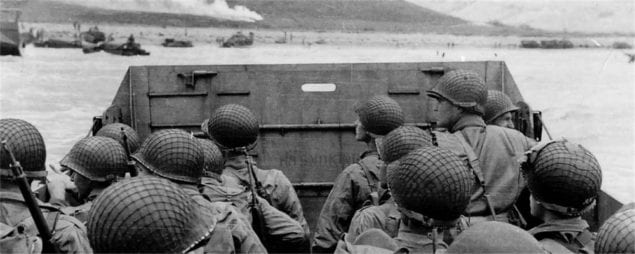June 6 of this year will mark the 75th anniversary of the historic D-Day invasion of Europe by Allied forces.
Although the numbers of American military veterans who participated in the massive coastal assault are dwindling —those living are now in their mid-90s — there are still some who recall firsthand the Allied military effort that set in motion the end of Nazi Germany’s control of Europe.
Also called Operation Overlord or the Normandy Invasion, the assault was launched on June 6, 1944 with the simultaneous landing of U.S., British, and Canadian forces on five separate beachheads in Normandy, France. General Dwight Eisenhower originally had selected June 5, 1944, as the date for the invasion but bad weather on the days leading up to the operation caused it to be delayed for 24 hours.
In one of the largest amphibious military assaults in history, after extensive planning and a large-scale deception campaign designed to mislead the Germans about the intended invasion target, roughly 156,000 American, British and Canadian forces landed along a 50-mile stretch of Normandy’s heavily fortified coast. Involved were 6,039 sea vessels and 11,590 aircraft. Casualty estimates vary, depending upon the source and method of calculating them, but thousands of Americans died in the initial assault, with many more wounded.
Leo J. LaChapelle, known to many of his friends as “Frenchie,” participated in D-Day. Now a Homestead resident and a member of the Veterans of Foreign Wars Post there, LaChapelle said he is “94 and three quarters” years of age. He served as a gunner aboard Navy aircraft — first with Squadron 84 operating PBY Catalina amphibious aircraft over the North Atlantic and Arctic, receiving a Presidential Unit Citation for sinking six German U Boats — then on the aptly named B-24 Liberator bombers. He later flew missions in the Pacific.
“Before D-Day I was on patrol bombers operating out of Iceland,” LaChapelle said. “Then I was transferred to England to help provide support for the invasion. We were coming under a lot of fire from the German gunners.”
The Battle of Normandy lasted from June 1944 to August 1944, by which time all of northern France had been liberated. By the following spring the Allies had defeated the Germans.
American Legion Post 133 in Palmetto Bay is named after the first local serviceman to die in WWII. Marlin Moore was a B-26 tail gunner shot down over France in August 1944 and is buried in Normandy France.









Comments are closed.